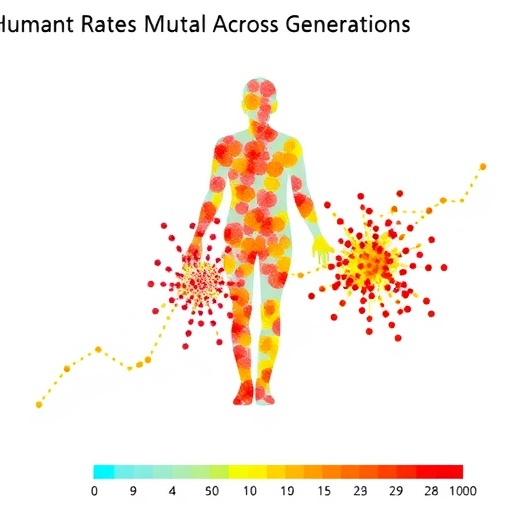
A groundbreaking investigation into the mutation dynamics of tandem repeats (TRs) within the human genome has revealed unprecedented insights into their de novo mutation rates, patterns of inheritance, and recurrence across multiple generations. Employing state-of-the-art high-fidelity (HiFi) long-read sequencing combined with complementary sequencing technologies, researchers meticulously genotyped an expansive collection of TR loci, offering a comprehensive landscape of their mutational behavior in a four-generation human pedigree.
Tandem repeats, repetitive DNA sequences consisting of short motifs ranging from homopolymers (single-base repeats) to longer motifs encompassing variable number tandem repeats (VNTRs), contribute significantly to genomic variability and evolutionary processes. Despite their known relevance, the precise rates and characteristics of their spontaneous mutations have remained difficult to quantify, largely due to technical challenges in accurately genotyping these repetitive regions, especially in short-read sequencing data. This study circumvented these obstacles by leveraging HiFi sequencing and the Tandem Repeat Genotyping Tool (TRGT), enabling robust genotyping across over 7.6 million TR loci within a well-characterized pedigree.
The team achieved Mendelian concordance for 93.4% of analyzed TR loci, underscoring the accuracy of their genotyping approach. By applying TRGT-denovo, a specialized algorithm for identifying novel mutations, they pinpointed candidate de novo mutations (DNMs) at TR loci with high coverage criteria, ensuring confident detection. Crucially, the use of orthogonal sequencing technologies, including Element sequencing known for its low error rates especially following homopolymer tracts, provided an invaluable validation layer, affirming the fidelity of detected TR alleles.
Element sequencing data demonstrated remarkably low stutter noise and superior accuracy in quantifying homopolymer lengths when compared to conventional Illumina sequencing. This distinction ameliorated long-standing concerns surrounding the assessment of homopolymer-associated mutations, though validation rates for DNMs in homopolymers remained modest, reflecting persistent technical nuances inherent to these repetitive sequences.
Validation efforts revealed that approximately 70% of assessable de novo short tandem repeat (STR) mutations were reproducible using Element reads, with validation rates significantly higher for non-homopolymer STRs compared to homopolymeric sequences. Furthermore, transmission analysis across generations confirmed that 75% of candidate de novo TR mutations in the third generation were transmitted to offspring, validating their germline origin. Notably, this transmission rate remains lower than that observed for single nucleotide variants (SNVs), highlighting ongoing challenges in fully characterizing TR mutational dynamics.
Extrapolating from these findings, the study estimated an average de novo TR mutation rate of approximately 4.74 × 10⁻⁶ mutations per locus per haplotype per generation. This rate reflects substantial variability across motif classes and sizes, with short tandem repeats exhibiting higher mutation frequencies relative to longer VNTRs. The majority of TR mutations involved expansions or contractions of STR motifs, with a minority affecting more complex loci combining STR and VNTR features.
Intriguingly, the paternal germline was implicated as the predominant source of de novo TR mutations, accounting for roughly 75% of phased mutations. This paternal bias aligns with patterns observed in other classes of genetic variation and underscores the influence of male meiosis in shaping the mutational landscape of repetitive sequences. The study also uncovered motif-size dependent mutation rates, identifying dinucleotide repeats as particularly mutable, and observed an upward trend in mutation frequency correlating with motif length beyond six base pairs.
Beyond point estimates, the researchers documented the occurrence of recurrent mutations at specific TR loci within the pedigree. They cataloged a set of 32 high-confidence loci exhibiting multiple independent mutational events either within a single generation or spanning across generations. Such recurrence suggests regions prone to heightened mutability or potentially reflects mosaicism within parental germlines. A detailed example on chromosome 8 illustrated a complex TR locus undergoing repeated expansions and contractions, confirmed through inheritance analyses and supported by both HiFi and Oxford Nanopore long-read sequencing data.
These recurrent events not only emphasize the dynamic nature of TR mutagenesis but also caution against simplistic interpretations of mutation causality at these hotspots. The interplay of mutational mechanisms, selection pressures, and functional consequences at these loci remains an exciting avenue for further inquiry, particularly in the context of disease association and genome evolution.
Methodologically, this work pushes the frontier of repeat genomics by integrating multiple complementary sequencing platforms and deploying cutting-edge computational tools designed specifically for the complexities of TR regions. The fusion of accurate genotyping, stringent validation, and multigenerational inheritance data offers an unprecedented resolution to quantify and contextualize de novo mutation rates in repetitive DNA.
While illuminating, this research also exposes lingering challenges, notably the reduced confidence in homopolymer mutation characterization and the lower transmission detection rate compared to SNVs. These limitations invite ongoing technological refinement and underscore the necessity of diverse sequencing strategies to comprehensively capture the full spectrum of genomic variation.
Collectively, this study transforms our understanding of human tandem repeat mutagenesis, bridging a critical knowledge gap with implications spanning evolutionary biology, genetics, and medical genomics. As TR mutations are increasingly implicated in neurological disorders, cancer, and other conditions, these insights pave the way for enhanced diagnostic precision and inform models of genome stability and inheritance.
Looking ahead, the frameworks established herein set a foundation for expansive population-scale analyses, integration with functional genomics assays, and explorations of environmental or epigenetic influences shaping TR mutation landscapes. The emergent picture portrays a genome in flux, where tandem repeats serve as both architects and records of human genetic diversity across generations.
Subject of Research: Human de novo mutation rates in tandem repeats using a multigenerational pedigree.
Article Title: Human de novo mutation rates from a four-generation pedigree reference.
Article References:
Porubsky, D., Dashnow, H., Sasani, T.A. et al. Human de novo mutation rates from a four-generation pedigree reference. Nature (2025). https://doi.org/10.1038/s41586-025-08922-2
Image Credits: AI Generated
Tags: advanced mutation detection algorithmschallenges in short-read sequencingcomprehensive pedigree analysisde novo mutation ratesgenomic variability and evolutionhigh-fidelity long-read sequencinghuman genome sequencinginheritance patterns of mutationsMendelian inheritance in humanstandem repeat dynamicsTR loci genotyping techniquesVNTR mutation characteristics





